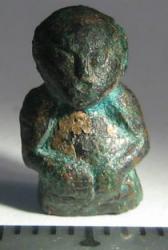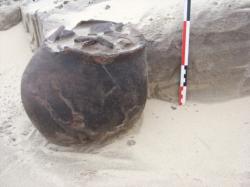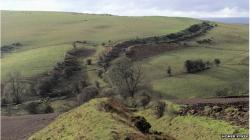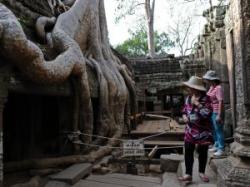INSTITUT SUPERIEUR D'ANTHROPOLOGIE
INSTITUTE OF ANTHROPOLOGY
ONLINE COURSES / COURS A DISTANCE
SUMMER TERM : JULY 2014
REGISTER NOW
SUEDE –  Uppsala. - This little guy is the new face of Old Uppsala. Most likely a religious amulet, being too small for a gaming piece, he showed up as a corroded lump in a cremation grave of the Late Vendel Period, early-8th century. The same grave also yielded a lovely millefiori glass bird gem, glass beads, and very unusually for its time, molten remains of silver objects. To my knowledge this is the richest female Vendel Period grave found to date at the old nucleus of Svealand, that is, the best candidate for the grave of an 8th century Queen of the Swedes.
Uppsala. - This little guy is the new face of Old Uppsala. Most likely a religious amulet, being too small for a gaming piece, he showed up as a corroded lump in a cremation grave of the Late Vendel Period, early-8th century. The same grave also yielded a lovely millefiori glass bird gem, glass beads, and very unusually for its time, molten remains of silver objects. To my knowledge this is the richest female Vendel Period grave found to date at the old nucleus of Svealand, that is, the best candidate for the grave of an 8th century Queen of the Swedes.
http://scienceblogs.com/aardvarchaeology/2014/04/08/the-new-face-of-old-uppsala/?
QATAR –  Rubayaqa / Ruwayda - Experts from a Welsh university are helping a Gulf state reveal the secrets of its past through a major international project. A team led by Lampeter-based archaeologist Andrew Peterson has targeted Islamic period sites in Qatar."The excavation of a site called Ras 'Ushairiq uncovered a large settlement called Rubayaqa which revealed several large courtyard homes, a mosque and two cemeteries."Finds from the site were as diverse as iron cannon balls to wooden chess pieces and large quantities of ceramics. "A second site called Ruwayda has revealed the remains of a town which was dominated by a large fortress. "It includes a mosque complex, workshops and warehouses and a tomb. "Other finds, such as ceramics, indicate long-distance trade with nations such as China, Oman, Iran and India," the archaeologist added.
Rubayaqa / Ruwayda - Experts from a Welsh university are helping a Gulf state reveal the secrets of its past through a major international project. A team led by Lampeter-based archaeologist Andrew Peterson has targeted Islamic period sites in Qatar."The excavation of a site called Ras 'Ushairiq uncovered a large settlement called Rubayaqa which revealed several large courtyard homes, a mosque and two cemeteries."Finds from the site were as diverse as iron cannon balls to wooden chess pieces and large quantities of ceramics. "A second site called Ruwayda has revealed the remains of a town which was dominated by a large fortress. "It includes a mosque complex, workshops and warehouses and a tomb. "Other finds, such as ceramics, indicate long-distance trade with nations such as China, Oman, Iran and India," the archaeologist added.
http://www.bbc.com/news/uk-wales-mid-wales-26858874
FRANCE –  Dune du Pilat - Cet hiver, à la faveur de l'érosion, des archéologues ont découvert une urne funéraire en parfait état datant de 8 siècles avant J-C. Les recherches se poursuivent à flanc de dune mais les scientifiques pensent avoir découvert le site d'une nécropole. Ils avaient déjà trouvé une zone d'habitat datant de l'âge du fer au pied du parking de la Corniche. La Dune du Pilat à La Teste-de-Buch vient d'être le théâtre d'une découverte archéologique majeure. Des archéologues ont retrouvé cet hiver dans le sable une urne funéraire datant de l'âge du fer, soit 800 ans avant J-C. L'objet, parfaitement conservé contient des fragments d'os calcinés, preuve d'une crémation à cet endroit précis. L'objet en céramique est apparu à la surface suite aux tempêtes et à l'érosion de la Dune du Pilat. C'est un touriste qui a vu l'objet et qui l'a immédiatement signalé à une équipe d'archéologues qui fouillent le site depuis plusieurs années. Philippe Jacques, l'un de ces chercheurs, pense être en présence d'une nécropole. Philippe Jacques est désormais persuadé que l'emplacement actuel de la Dune du Pilat abritait un village de l'âge du fer. Les archéologues continuent leurs fouilles mais ils doivent aller vite avant que le sable, qui avait disparu lors des tempêtes ne viennent recouvrir la dune. Ils préparent aussi une exposition.
Dune du Pilat - Cet hiver, à la faveur de l'érosion, des archéologues ont découvert une urne funéraire en parfait état datant de 8 siècles avant J-C. Les recherches se poursuivent à flanc de dune mais les scientifiques pensent avoir découvert le site d'une nécropole. Ils avaient déjà trouvé une zone d'habitat datant de l'âge du fer au pied du parking de la Corniche. La Dune du Pilat à La Teste-de-Buch vient d'être le théâtre d'une découverte archéologique majeure. Des archéologues ont retrouvé cet hiver dans le sable une urne funéraire datant de l'âge du fer, soit 800 ans avant J-C. L'objet, parfaitement conservé contient des fragments d'os calcinés, preuve d'une crémation à cet endroit précis. L'objet en céramique est apparu à la surface suite aux tempêtes et à l'érosion de la Dune du Pilat. C'est un touriste qui a vu l'objet et qui l'a immédiatement signalé à une équipe d'archéologues qui fouillent le site depuis plusieurs années. Philippe Jacques, l'un de ces chercheurs, pense être en présence d'une nécropole. Philippe Jacques est désormais persuadé que l'emplacement actuel de la Dune du Pilat abritait un village de l'âge du fer. Les archéologues continuent leurs fouilles mais ils doivent aller vite avant que le sable, qui avait disparu lors des tempêtes ne viennent recouvrir la dune. Ils préparent aussi une exposition.
http://www.francebleu.fr/infos/fouilles-archeologiques/decouverte-probable-d-une-necropole-de-l-age-du-fer-sous-la-dune-du-pilat-1424845
ROYAUME UNI –  Offa's Dyke - Archaeologists have uncovered evidence which suggests that Offa's Dyke may have been built up to 200 years earlier than thought. Samples from Clwyd-Powys Archaeological Trust excavations on a stretch of the dyke have been radiocarbon dated to the second half of the 6th Century. Historians have always associated the dyke with King Offa who ruled the kingdom of Mercia in the 8th Century. But now archaeologists believe it might have been in use before he ruled. The trust said it was a "tremendously exciting discovery".The excavations were taken from a section of the protected ancient monument at Chirk near the Shropshire border.It had been believed that the linear earthwork stretching 177 miles (285km) was built by King Offa of Mercia during his reign between 757 and 796. However there has been no firm archaeological evidence to support this.Carbon dating tests revealed a 95% probability that the Chirk section of the dyke had been built between 430 and 652. "It is now likely that parts of the dyke system was in place before Offa's time but it is also likely that he would have consolidated the existing network into what we now call Offa's Dyke," said Mr Belford. "It is now clear that it was not the work of a single ruler but a longer-term project that began at an earlier stage in the development of the kingdom." Offa's Dyke is the longest linear earthwork in the UK, and one of the longest in Europe.
Offa's Dyke - Archaeologists have uncovered evidence which suggests that Offa's Dyke may have been built up to 200 years earlier than thought. Samples from Clwyd-Powys Archaeological Trust excavations on a stretch of the dyke have been radiocarbon dated to the second half of the 6th Century. Historians have always associated the dyke with King Offa who ruled the kingdom of Mercia in the 8th Century. But now archaeologists believe it might have been in use before he ruled. The trust said it was a "tremendously exciting discovery".The excavations were taken from a section of the protected ancient monument at Chirk near the Shropshire border.It had been believed that the linear earthwork stretching 177 miles (285km) was built by King Offa of Mercia during his reign between 757 and 796. However there has been no firm archaeological evidence to support this.Carbon dating tests revealed a 95% probability that the Chirk section of the dyke had been built between 430 and 652. "It is now likely that parts of the dyke system was in place before Offa's time but it is also likely that he would have consolidated the existing network into what we now call Offa's Dyke," said Mr Belford. "It is now clear that it was not the work of a single ruler but a longer-term project that began at an earlier stage in the development of the kingdom." Offa's Dyke is the longest linear earthwork in the UK, and one of the longest in Europe.
http://www.bbc.com/news/uk-wales-mid-wales-26921202?
MALAISIE –  Gua Tambun-A local politician has raised awareness that the rock art site of Gua Tambun is under threat from vandalism. Gua Tambun was the site I investigated for my MA thesis – and yes, the site has been quite heavily vandalised because it is open to public – litter, graffiti on the walls – the latter of which is problematic because while most of the paintings are high up on the cliff wall, there are some paintings at floor level.
Gua Tambun-A local politician has raised awareness that the rock art site of Gua Tambun is under threat from vandalism. Gua Tambun was the site I investigated for my MA thesis – and yes, the site has been quite heavily vandalised because it is open to public – litter, graffiti on the walls – the latter of which is problematic because while most of the paintings are high up on the cliff wall, there are some paintings at floor level.
http://www.southeastasianarchaeology.com/2014/04/06/malaysian-rock-art-site-under-threat-of-vandalism/#more-9505
CAMBODGE –  Angkor Wat - Cambodia's Angkor Wat has been digitally mapped for the first time, allowing people to visit the World Heritage Site from the comfort of their armchair using Google Street View. The project is part of a growing trend aimed at Internet users who might otherwise never have the chance to visit the cultural and architectural wonders of the world. Google took more than a million photos of Angkor - the result is 90 000 360-degree views of more than 100 temples. Street View allows web users to zoom in on an area, and then explore.
Angkor Wat - Cambodia's Angkor Wat has been digitally mapped for the first time, allowing people to visit the World Heritage Site from the comfort of their armchair using Google Street View. The project is part of a growing trend aimed at Internet users who might otherwise never have the chance to visit the cultural and architectural wonders of the world. Google took more than a million photos of Angkor - the result is 90 000 360-degree views of more than 100 temples. Street View allows web users to zoom in on an area, and then explore.
http://www.iol.co.za/scitech/technology/internet/google-digitises-angkor-wat-1.1671441#.U0LS7Pl_vVQ